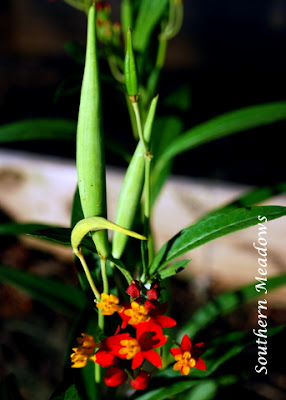GBBD September: Going to Seed
It is beginning to feel a little more like Fall with some slightly cooler temperatures (upper 80's day time and upper 60's night time). A few drops of rain have graced my Georgia garden and the plants, wildlife and gardener have be re-energized.
While some plants are preparing for their winter dormancy, many plants in my gardening are preparing for the next generation while others are getting ready for a fall bloom.
While some plants are preparing for their winter dormancy, many plants in my gardening are preparing for the next generation while others are getting ready for a fall bloom.
The dogwood trees are displaying their fruit. These berries are an excellent source of food for the birds. Bluebirds, Brown Thrashers, Cardinals, Mockingbirds, Robins, Woodpeckers, Vireos and Thrushes are some of the birds in my garden that forage on this fruit.
The fruit on the Beauty berry shrubs is also a favorite for a variety of wildlife. The Towhees, Robins, Cardinals, Mocking Birds, Finches and Thrashers are consumers of these berries as are white tailed deer. The fruit clusters are available starting in late summer all the way through early winter.
The Sumac trees are also bearing fruit which will be eaten by chickadees, blue jays and crows. The fruit is usually eaten during the winter months when other berries are no longer available. It is important to note here that this is a native plant but can also be invasive. Another important distinction is that this is non-poisonous. (Poisonous sumac grows in a swampy environment and can easily be identified in the fall from the non-poisonous because it has white berries that hang down)
Several plants are putting out their seed pods including Mexican Milkweed
Sweetshrub
the Hyacinth Bean vine,
and Crepe Myrtle.
The vegetable life does not content itself with casting from the flower or the tree a single seed, but it fills the air and earth with a prodigality of seeds, that, if thousands perish, thousands may plant themselves; that hundreds may come up, that tens may live to maturity; that at least one may replace the parent.
~ Ralph Waldo Emerson
Our very dry and hot summer has taken its toll on many of my blooming plants. Some like the Salvia, Sedum, Sage, Milkweed continue to bloom prolifically but others are a little worse for wear.
I am joining May Dreams Gardens for Garden Blogger Bloom Day.
Our very dry and hot summer has taken its toll on many of my blooming plants. Some like the Salvia, Sedum, Sage, Milkweed continue to bloom prolifically but others are a little worse for wear.
The Azaleas are showing their second round of blooms. Pretty but certainly not as prolific as spring time.
The knock out roses are coming back after a quiet summer. They aren't too fond of the heat and got quite a chewing on from the Japanese beetles in late spring/early summer.
The Hyacinth Bean vine is new to my garden this year. An annual in my Zone 7b garden, I have it in pots by my front door. It gets full on sun most of the day and it is thriving, having grown at least 8 ft. this season.
I have read that they are good re-seeders and are easily started indoors from seed. (Note that if you have young children the raw bean seeds are poisonous if ingested so it probably isn't a plant you would want to include in your garden.)
Butterflies are attracted to the blooms and is very popular amongst the skippers.
The Sedum is in full bloom and also enjoyed by many pollinators (see earlier posts Hairstreaks and Accidental Pollinators)
The Buddleia blooms are also frequented by many pollinators including butterflies, hummingbirds and clearwing hummingbird moths (shown in photo).
I hope you are also enjoying the beginnings of fall and all the changes nature has to offer in your garden.














.png)
